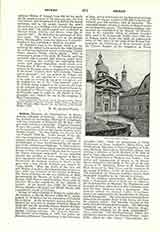

Seckau, Diocese of (SECOVIENSIS), in Styria, Austria, suffragan of Salzburg. The See of Seckau was founded by Archbishop Eberhard II of Salzburg, with the permission of Honorius III, June 22, 1218, and made suffragan of Salzburg. Emperor Frederick II gave his consent, October 26, 1218, and conferred on the incumbent of the see the dignity of prince of the Roman Empire. The first bishop was Provost Karl von Friesach (1218-30). Under Joseph II the diocese was reorganized and its territory enlarged. The original intention of that emperor, to establish an archbishopric at Graz, was frustrated by the opposition of the Archbishop of Salzburg. In 1786, however, the residence of the prince-bishop was transferred from Seckau to Graz, the capital of Styria, but the name of the diocese remained unchanged. A new cathedral chapter was installed at Graz, composed at first of three dignitaries and four canons. The see included thenceforth the Salzburg territory in Styria; at the same time a new diocese (Leoben) was created for Upper Styria. After the death of the first and only Bishop of Leoben, the administration of this see, since 1808, was entrusted to the bishops of Seckau. The limits of Seckau are due to a regulation of 1859, incorporating the Diocese of Leoben with that of Seckau, while Seckau ceded Southern Styria with its (chiefly) Slovenian population to the Diocese of Lavant. At the present time (1909) the Diocese of Seckau comprises all Upper and Middle Styria, with a population nearly all German.
Among the prince-bishops of Seckau in earlier days the foremost is Martin Brenner (1585-1615), distinguished by his labors for the restoration of Catholic life in Styria. In the nineteenth century Seckau was adorned by sueh men as Roman Sebastian Zangerle (1824-48) and the apostolic Johann Baptist Zwerger (1867-93), highly esteemed for his great zeal and his popular religious writings. Dr. Leopold Schuster, who became prince-bishop in 1893, was before his elevation professor of Church history in the University of Graz, and is well known for his historical writings. In 1910, the diocese numbered 937,000 Catholics, distributed over 336 parishes, with 45 deaneries. The cathedral chapter consists of eleven residential canons and six honorary canons. The following religious communities are established in the diocese: the Benedictines in the venerable Abbey of Admont (founded 1074) and at St. Lambrecht (1103); since 1883 also at Seckau, which house was made an independent abbey in 1887, and is in the hands of the Beuren Congregation; the Cistercians at Rein (founded 1129); the Canons Regular of St. Augustine at Vorau (founded 1163). There are Dominicans at Graz; Franciscans at Graz, Lankowitz, Maria-Trost, and Gleichenberg; Minorites at Graz; Capuchins at Leibnitz, Hartberg, Schwanberg, Knittelfeld, Murau, and Irdning; Carmelites at Graz; Brothers of St. John of God at Graz, Algersdorf, and Kainbach; Lazarists at Graz, Redemptorists at Mautern and Leoben. The orders and congregations of women in the diocese devote themselves principally to the care of the sick (Sisters of St. Elizabeth, Sisters of St. Vincent de Paul, Sisters of the Holy Cross) and the education of the young (Ursulines, Ladies of the Sacred Heart). The students of the diocesan seminary receive their theological education at the University of Graz.
Of the religious communities, the Benedictines have a theological school of their own at Admont; the Redemptorists at Mautern; the Dominicans and Lazarists at Graz, where there is also a diocesan seminary for boys connected with a gymnasium. Preparatory schools for classical studies (tinter-Gymnasien) are conducted by the Benedictines at Admont and St. Lambrecht. Not a few famous scientists have come from the secular clergy of the diocese and from the religious orders. The scientific services of the earlier monastic houses deserve praise. The following periodicals are carried on by the diocesan clergy: “Kirchliches Jahrbuch fur die kath. Geistlichkeit” (Graz, 1837-40); “Der Kirchenschmuck, Blatter des christlichen Kunstvereins der Diozese Seckau” (since 1870), edited by Joh. Graus; “Literarischer Anzeiger” (first with the restriction “zunachst fur den kath. Klerus der Kirchenprovins Salzburg”; since 1902, with the additional title “Katholisches Literaturblatt”) published since 1886, and conducted since 1902 by Gutjahr and Haring. Great zeal for the spread of Catholic literature is shown by the “Katholischer Pressverein”, to which is also due the foundation of the Catholic printing press and publishing house, “Styria“. The cathedral at Graz is rare monument of Gothic architecture. No less remarkable as ecclesiastical architecture are the churches of the ancient monasteries. In recent times the “Christlicher Kunstverein fur die Diozese Seckau” has fostered the study of Christian art in general and displayed rare practical interest in new ecclesiastical edifices and for the restoration of some older ones (Sacred Heart Church, Graz; Romanesque Cathedral, Seckau). The ancient pilgrimage of Mariazell (annually 80,000 to 100,000 pilgrims from all parts of Europe) is in the Diocese of Seckau.
FRIEDRICH LAUCHERT

